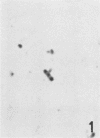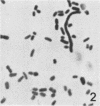Abstract
Two hemolytic phenotypes of Vibrio damsela, isolated from the tissue of a patient with a fatal wound infection, were characterized. The patient had underlying disease, and the wound was associated with an injury inflicted during the handling of a catfish. The phenotypes were morphologically and biochemically similar except for their lecithinase, lipase, and hemolytic activities. When grown on rabbit blood agar, one phenotype (LZ) produced a large zone of hemolysis (10 mm) around the colony, whereas the other type (SZ) produced only a small zone (1 to 2 mm). On sheep blood agar, the differences in hemolytic activity were more subtle. By a modified CAMP test in which V. damsela was streaked perpendicularly to Staphylococcus aureus, it was determined that a factor elaborated by the LZ phenotype (but not the SZ phenotype) protected sheep erythrocytes from the hemolysis normally caused by S. aureus toxins. Cell-free filtrates of broth cultures of each phenotype had the same effects on erythrocytes as did the organisms themselves.
Full text
PDF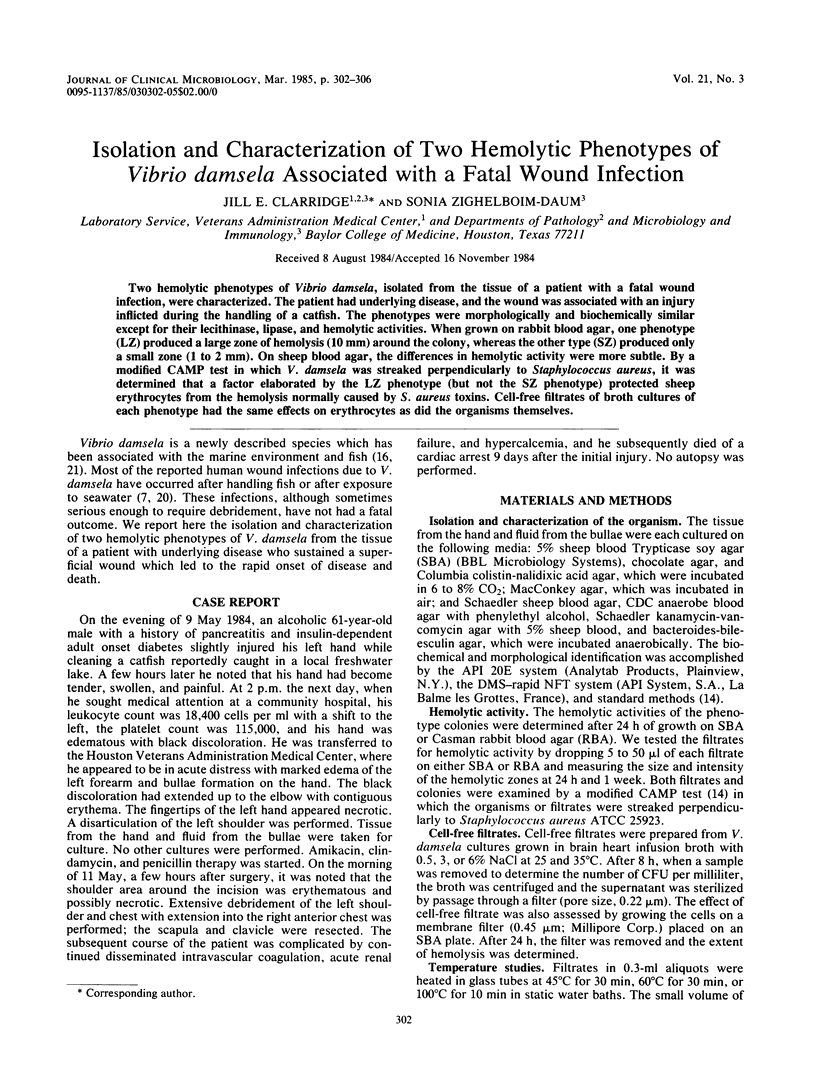
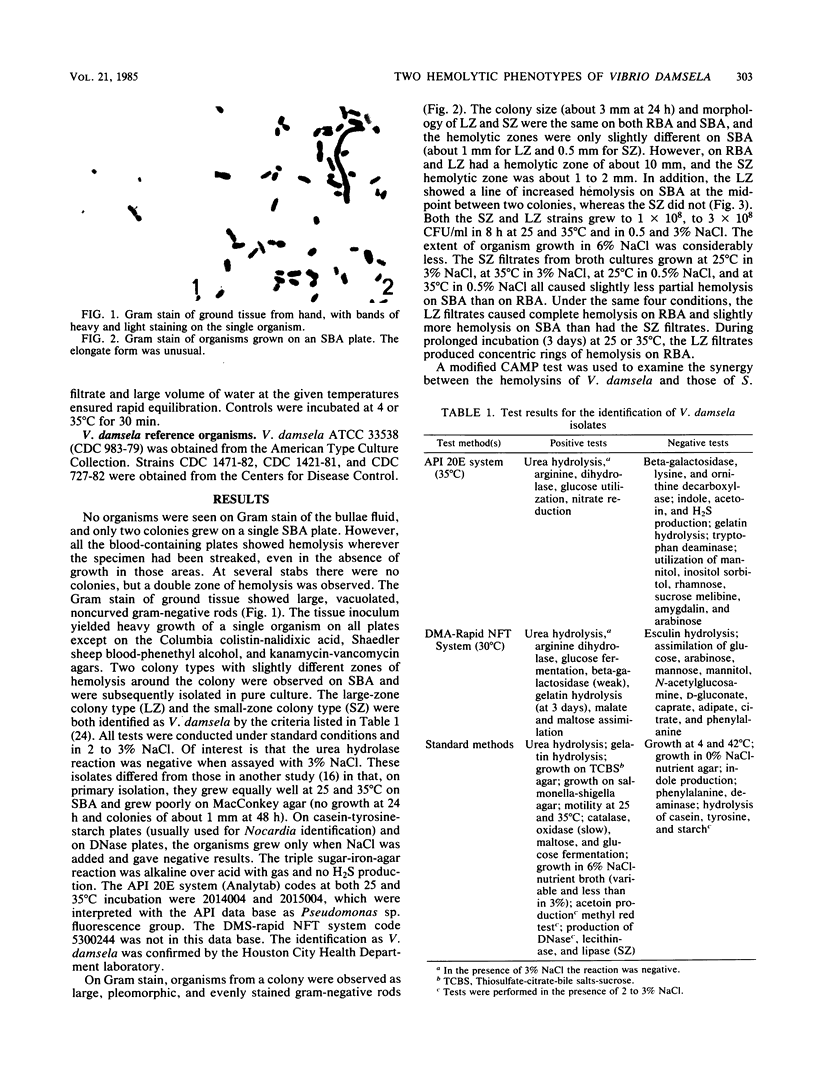
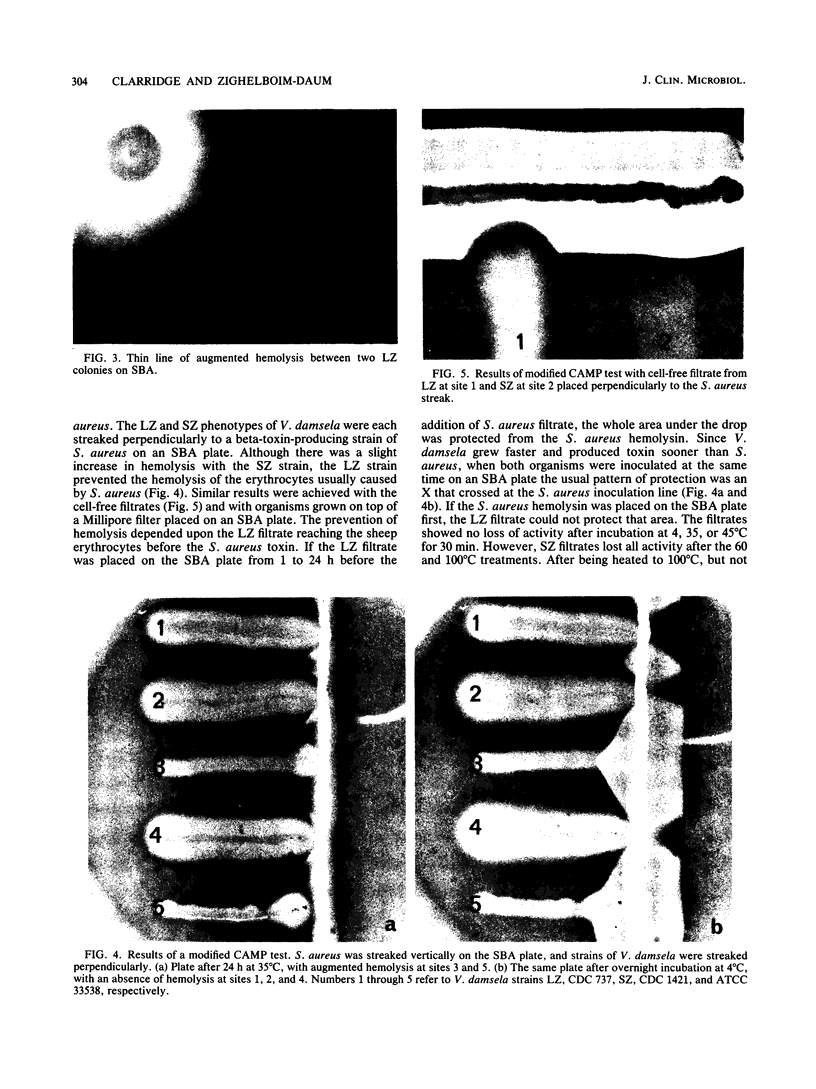
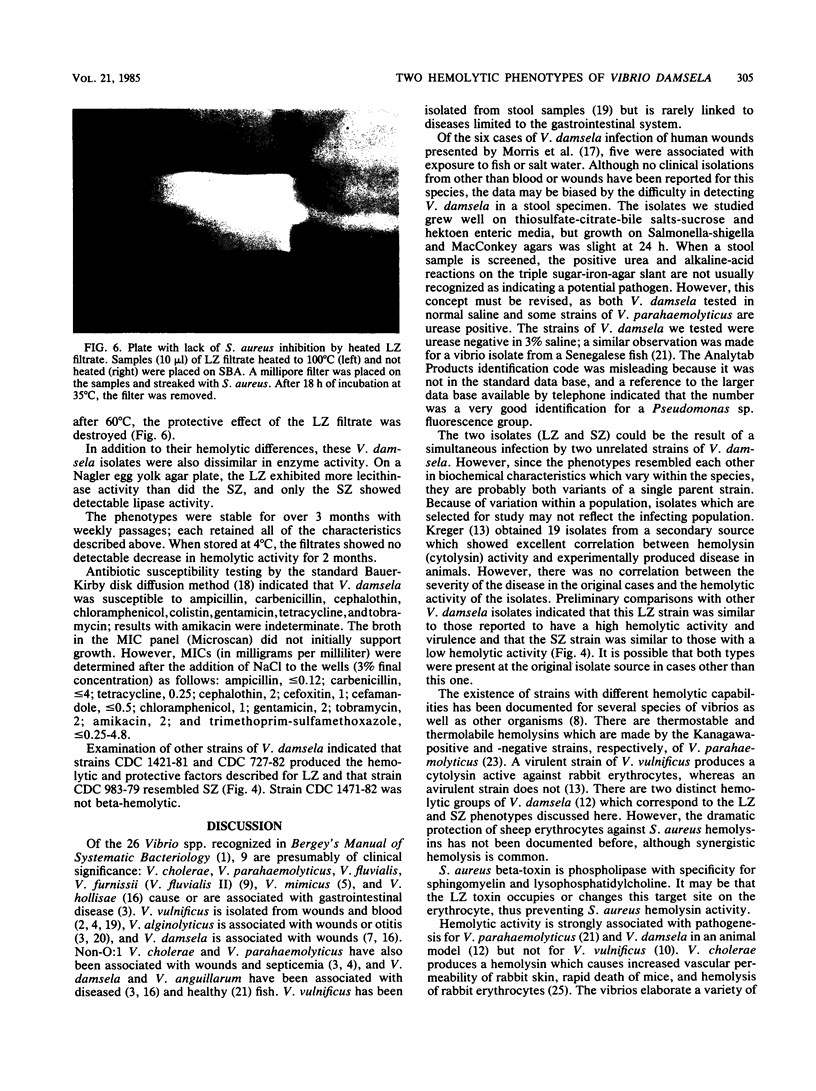
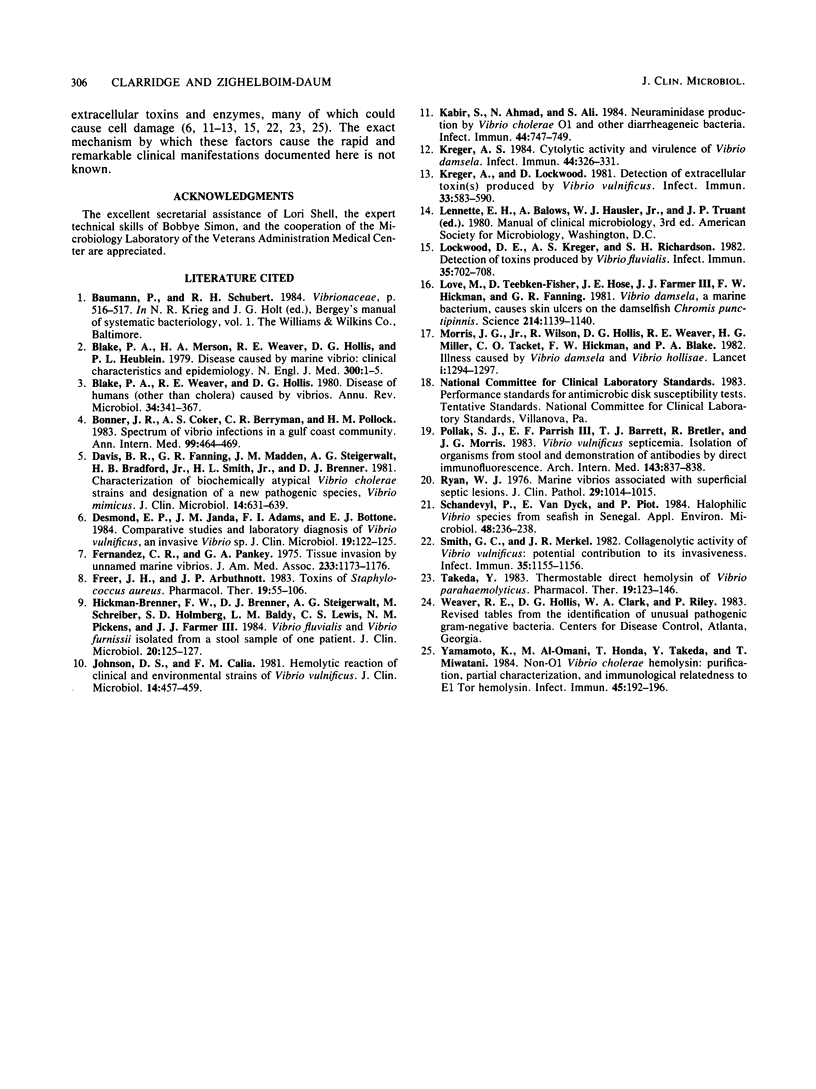
Images in this article
Selected References
These references are in PubMed. This may not be the complete list of references from this article.
- Blake P. A., Merson M. H., Weaver R. E., Hollis D. G., Heublein P. C. Disease caused by a marine Vibrio. Clinical characteristics and epidemiology. N Engl J Med. 1979 Jan 4;300(1):1–5. doi: 10.1056/NEJM197901043000101. [DOI] [PubMed] [Google Scholar]
- Blake P. A., Weaver R. E., Hollis D. G. Diseases of humans (other than cholera) caused by vibrios. Annu Rev Microbiol. 1980;34:341–367. doi: 10.1146/annurev.mi.34.100180.002013. [DOI] [PubMed] [Google Scholar]
- Bonner J. R., Coker A. S., Berryman C. R., Pollock H. M. Spectrum of Vibrio infections in a Gulf Coast community. Ann Intern Med. 1983 Oct;99(4):464–469. doi: 10.7326/0003-4819-99-4-464. [DOI] [PubMed] [Google Scholar]
- Davis B. R., Fanning G. R., Madden J. M., Steigerwalt A. G., Bradford H. B., Jr, Smith H. L., Jr, Brenner D. J. Characterization of biochemically atypical Vibrio cholerae strains and designation of a new pathogenic species, Vibrio mimicus. J Clin Microbiol. 1981 Dec;14(6):631–639. doi: 10.1128/jcm.14.6.631-639.1981. [DOI] [PMC free article] [PubMed] [Google Scholar]
- Desmond E. P., Janda J. M., Adams F. I., Bottone E. J. Comparative studies and laboratory diagnosis of Vibrio vulnificus, an invasive Vibrio sp. J Clin Microbiol. 1984 Feb;19(2):122–125. doi: 10.1128/jcm.19.2.122-125.1984. [DOI] [PMC free article] [PubMed] [Google Scholar]
- Fernandez C. R., Pankey G. A. Tissue invasion by unnamed marine vibrios. JAMA. 1975 Sep 15;233(11):1173–1176. [PubMed] [Google Scholar]
- Freer J. H., Arbuthnott J. P. Toxins of Staphylococcus aureus. Pharmacol Ther. 1982;19(1):55–106. doi: 10.1016/0163-7258(82)90042-0. [DOI] [PubMed] [Google Scholar]
- Hickman-Brenner F. W., Brenner D. J., Steigerwalt A. G., Schreiber M., Holmberg S. D., Baldy L. M., Lewis C. S., Pickens N. M., Farmer J. J., 3rd Vibrio fluvialis and Vibrio furnissii isolated from a stool sample of one patient. J Clin Microbiol. 1984 Jul;20(1):125–127. doi: 10.1128/jcm.20.1.125-127.1984. [DOI] [PMC free article] [PubMed] [Google Scholar]
- Johnson D. E., Calia F. M. Hemolytic reaction of clinical and environmental strains of Vibrio vulnificus. J Clin Microbiol. 1981 Oct;14(4):457–459. doi: 10.1128/jcm.14.4.457-459.1981. [DOI] [PMC free article] [PubMed] [Google Scholar]
- Kabir S., Ahmad N., Ali S. Neuraminidase production by Vibrio cholerae O1 and other diarrheagenic bacteria. Infect Immun. 1984 Jun;44(3):747–749. doi: 10.1128/iai.44.3.747-749.1984. [DOI] [PMC free article] [PubMed] [Google Scholar]
- Kreger A. S. Cytolytic activity and virulence of Vibrio damsela. Infect Immun. 1984 May;44(2):326–331. doi: 10.1128/iai.44.2.326-331.1984. [DOI] [PMC free article] [PubMed] [Google Scholar]
- Kreger A., Lockwood D. Detection of extracellular toxin(s) produced by Vibrio vulnificus. Infect Immun. 1981 Aug;33(2):583–590. doi: 10.1128/iai.33.2.583-590.1981. [DOI] [PMC free article] [PubMed] [Google Scholar]
- Lockwood D. E., Kreger A. S., Richardson S. H. Detection of toxins produced by vibrio fluvialis. Infect Immun. 1982 Feb;35(2):702–708. doi: 10.1128/iai.35.2.702-708.1982. [DOI] [PMC free article] [PubMed] [Google Scholar]
- Love M., Teebken-Fisher D., Hose J. E., Farmer J. J., 3rd, Hickman F. W., Fanning G. R. Vibrio damsela, a Marine Bacterium, Causes Skin Ulcers on the Damselfish Chromis punctipinnis. Science. 1981 Dec 4;214(4525):1139–1140. doi: 10.1126/science.214.4525.1139. [DOI] [PubMed] [Google Scholar]
- Morris J. G., Jr, Miller H. G., Wilson R., Tacket C. O., Hollis D. G., Hickman F. W., Weaver R. E., Blake P. A. Illness caused by Vibrio damsela and Vibrio hollisae. Lancet. 1982 Jun 5;1(8284):1294–1297. doi: 10.1016/s0140-6736(82)92853-7. [DOI] [PubMed] [Google Scholar]
- Pollak S. J., Parrish E. F., 3rd, Barrett T. J., Dretler R., Morris J. G., Jr Vibrio vulnificus septicemia. Isolation of organism from stool and demonstration of antibodies by indirect immunofluorescence. Arch Intern Med. 1983 Apr;143(4):837–838. doi: 10.1001/archinte.143.4.837. [DOI] [PubMed] [Google Scholar]
- Ryan W. J. Marine vibrios associated with superficial septic lesions. J Clin Pathol. 1976 Nov;29(11):1014–1015. doi: 10.1136/jcp.29.11.1014. [DOI] [PMC free article] [PubMed] [Google Scholar]
- Schandevyl P., Van Dyck E., Piot P. Halophilic Vibrio species from seafish in Senegal. Appl Environ Microbiol. 1984 Jul;48(1):236–238. doi: 10.1128/aem.48.1.236-238.1984. [DOI] [PMC free article] [PubMed] [Google Scholar]
- Smith G. C., Merkel J. R. Collagenolytic activity of Vibrio vulnificus: potential contribution to its invasiveness. Infect Immun. 1982 Mar;35(3):1155–1156. doi: 10.1128/iai.35.3.1155-1156.1982. [DOI] [PMC free article] [PubMed] [Google Scholar]
- Takeda Y. Thermostable direct hemolysin of Vibrio parahaemolyticus. Pharmacol Ther. 1982;19(1):123–146. doi: 10.1016/0163-7258(82)90044-4. [DOI] [PubMed] [Google Scholar]
- Yamamoto K., Al-Omani M., Honda T., Takeda Y., Miwatani T. Non-O1 Vibrio cholerae hemolysin: purification, partial characterization, and immunological relatedness to El Tor hemolysin. Infect Immun. 1984 Jul;45(1):192–196. doi: 10.1128/iai.45.1.192-196.1984. [DOI] [PMC free article] [PubMed] [Google Scholar]



